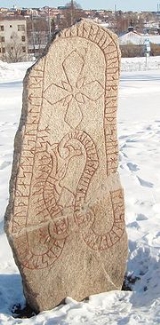
Frösö Runestone
Encyclopedia
Frösöstenen is the northern-most raised runestone in the World and Jämtland
's only runestone. It originally stood at the tip of ferry
terminal on the sound
between the island of Frösön
and Östersund
.
On it is inscribed:
The following Old Norse person and place names appear in the inscription:
The stone is also unique in that it was done in memory of Austmaðr's Christianization of Jämtland and bridge building, rather than as a cenotaph
. The stone dates to between 1030 and 1050. It has now been relocated to the lawn in front of the local county seat due to the construction of a new bridge, between 1969 and 1971, on the original site.
Jämtland
Jämtland or Jamtland is a historical province or landskap in the center of Sweden in northern Europe. It borders to Härjedalen and Medelpad in the south, Ångermanland in the east, Lapland in the north and Trøndelag and Norway in the west...
's only runestone. It originally stood at the tip of ferry
Ferry
A ferry is a form of transportation, usually a boat, but sometimes a ship, used to carry primarily passengers, and sometimes vehicles and cargo as well, across a body of water. Most ferries operate on regular, frequent, return services...
terminal on the sound
Sound (geography)
In geography a sound or seaway is a large sea or ocean inlet larger than a bay, deeper than a bight and wider than a fjord; or it may be defined as a narrow sea or ocean channel between two bodies of land ....
between the island of Frösön
Frösön
Frösön is a small island in the lake Storsjön located west of the city Östersund in Jämtland. For ages this island was the regional centre of Jämtland....
and Östersund
Östersund
Östersund is an urban area in Jämtland in the middle of Sweden. It is the seat of Östersund Municipality and the capital of Jämtland County. Östersund is located at the shores of Sweden's fifth largest lake, Storsjön, opposite the island Frösön, and is the only city in Jämtland. Östersund is the...
.
On it is inscribed:
- Austmaðr, Guðfastr's son, had this stone raised and this bridge built and ChristianizedChristianizationThe historical phenomenon of Christianization is the conversion of individuals to Christianity or the conversion of entire peoples at once...
Jämtland. Ásbjörn built the bridge. Trjónn and Steinn carved these runesRunic alphabetThe runic alphabets are a set of related alphabets using letters known as runes to write various Germanic languages before the adoption of the Latin alphabet and for specialized purposes thereafter...
.
The following Old Norse person and place names appear in the inscription:
- Austmaðr (Man from the East) - An Old West Norse speaking man from Mainland ScandinaviaScandinaviaScandinavia is a cultural, historical and ethno-linguistic region in northern Europe that includes the three kingdoms of Denmark, Norway and Sweden, characterized by their common ethno-cultural heritage and language. Modern Norway and Sweden proper are situated on the Scandinavian Peninsula,...
. Similarly, Vestmaðr (English: Man from the West) was an Old West Norse-speaking BritonBritish IslesThe British Isles are a group of islands off the northwest coast of continental Europe that include the islands of Great Britain and Ireland and over six thousand smaller isles. There are two sovereign states located on the islands: the United Kingdom of Great Britain and Northern Ireland and...
. - Guðfastr (English: He who is faithful to God)
- Jamtaland (English: Land of the "Jamtar"- The Old Norse name for Jämtland where jamti may mean 'hard-working person'; cf. German adjective emsig 'hard-working'.
- Ásbjörn (English: God Bear)
- Trjónn - (English: Snout - A name more or less specific to Jämtland, and also found in several Medieval documents from Jämtland)
- Steinn (English: Stone)
The stone is also unique in that it was done in memory of Austmaðr's Christianization of Jämtland and bridge building, rather than as a cenotaph
Cenotaph
A cenotaph is an "empty tomb" or a monument erected in honour of a person or group of people whose remains are elsewhere. It can also be the initial tomb for a person who has since been interred elsewhere. The word derives from the Greek κενοτάφιον = kenotaphion...
. The stone dates to between 1030 and 1050. It has now been relocated to the lawn in front of the local county seat due to the construction of a new bridge, between 1969 and 1971, on the original site.
See also
- Arnljot
- Christianization of ScandinaviaChristianization of ScandinaviaThe Christianization of Scandinavia took place between the 8th and the 12th century. The realms of Scandinavia proper, Denmark, Norway and Sweden, established their own Archdioceses, responsible directly to the Pope, in 1104, 1154 and 1164, respectively...
- Joint Nordic database for runic inscriptions
- Runestone
- Runic alphabetRunic alphabetThe runic alphabets are a set of related alphabets using letters known as runes to write various Germanic languages before the adoption of the Latin alphabet and for specialized purposes thereafter...

